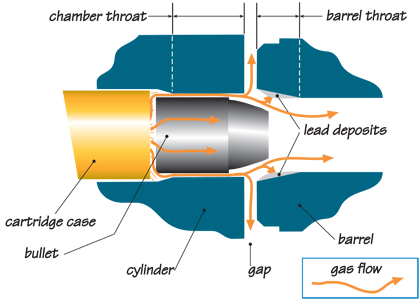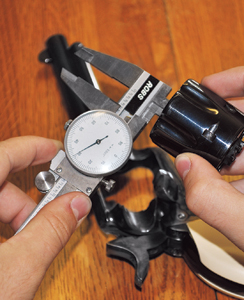January 04, 2011
By Allan Jones
By Allan Jones
 Gas escaping around the bullet in the chamber throat is the cause of most revolver leading. |
Lead fouling used to make me crazy. Fortunately, a part of my brain retained some degree of sanity and worked toward understanding the causes. Most of this column covers leading in handguns, specifically revolvers.First, let me establish some definitions. I'm not talking about the thin wash of lead that readily yields to a good bore brush in normal cleaning. Rather, it's the clumps of lead that destroy accuracy, resist removal, and, in extreme cases, damage the firearm that concern me.
There's More Than One Kind
Most of us associate leading with excessive velocity, aggravated by a too-soft lead alloy and/or insufficient or ineffective lubrication. There is another kind that probably plagues more revolver shooters--gas blow-by.
Advertisement
When I was new to this reloading game, the popular literature covered only the first cause. Common sense says that velocity leading should get worse as the bullet speeds up in the gun barrel. After all, maximum velocity is usually reached at the muzzle. Therefore, I figured that leading should be light to nonexistent at the breech end of the barrel and grow heavier toward the muzzle, reflecting an accelerating bullet.
That's fine, but the leading I experienced early on with a particular .45 Colt-caliber revolver was heaviest at the breech end of the barrel and extended onto the back of the barrel, the frame, and the cylinder face. This was happening even with hard-cast bullets, and I'd tried a variety of good lubricants. In no way did that fit the logical pattern of velocity leading. Nothing helped, not even changing to gascheck bullets; something else was afoot.
Advertisement
It became apparent that lead-laden gas escaped around the bullet early in the firing cycle and carried its load to areas close to the exit hole in the cylinder. I had some Ideal No. 45468 bullets (that's a lightweight .45-caliber bullet with a dimple in the base). They were soft-cast for a cap-and-ball revolver, but I loaded some in .45 Colt and tried a charge of Unique that, with most other lead bullets, causes leading. Guess what? There was very little leading.
The problem was one of bullet fit--in this case, the fit of the bullet in the revolver's chamber throat. In further experimenting with flat-base bullets, I found I could often keep the load the same and use a softer alloy and the leading lessened. The soft bullet was "slugging up" in the chamber throat and providing a better gas seal.
Low-pressure revolver loads can cause serious blow-by leading. Once, while taking calls on the Speer tech lines, a caller said that .38 Special hollowbase wadcutters were leading up the throats and the back of the barrel of his S&W K-38. I asked if he was using 2.4 grains of Bullseye, and there was a long silence. Finally, he said he was using that exact charge. I explained that I'd had the same experience, and it went away when I increased the charge weight to 2.7 grains. The 2.4-grain load did not produce enough pressure to expand the wadcutter's skirt, whereas 2.7 grains seemed to be the sweet spot for sufficient pressure without too much velocity and recoil. A week later he called back to say that he'd tried the heavier charge and his old K-38 was shooting very well with no serious leading, in spite of his initial skepticism of my advise.
It All Comes Down To Fit
The hollow- or dished-base bullet helps fill up the chamber throat but must not be too hard an alloy. However, most lead bullets have flat bases that require more pressure to expand and keep the gas behind the bullet. At that point, it all comes down to fit.
 Knowing chamber throat diameters is important to reducing lead fouling. |
Good lead bullet performance depends on the chamber throats not being too much larger than the barrel's groove diameter. I have a revolver in .45 Colt that came with a 0.4525-inch groove diameter, but the chamber throats were closer to 0.457 inch. It leaded badly with loads that shot fine in other revolvers. The gunmaker replaced the original cylinder with one with chamber throats that were only 0.0005 inch larger than the groove diameter. This is now my most accurate revolver, and I can drive soft lead bullets fast enough to produce true velocity leading without any of the previous lead build-up at the breech end.
It's rare to find that tight a fit outside of a custom model, but I've found that if chamber throats are no more than 0.002 inch over groove diameter, you will get quite decent accuracy and minimal leading. This small difference can be made up with bullet diameter and alloy choices.
When sizing cast lead bullets, make them as large as possible without bulging the case to the point where it won't chamber. I size .38 Spl. bullets at 0.359 inch, and they shoot fine in all my revolvers, including a couple of older Colts whose groove diameters are closer to 0.355 inch. I find that 0.430-inch sizing works well in all my .44 Specials and Magnums, none of which have throats larger than 0.431 inch. The beloved .45 Colt still gets 0.454-inch cast bullets.
The important issue here is to know your chamber throat diameters. A good pair of dial calipers will tell you all you need to know.
I also shoot lead in most of my semiautomatic pistols. I bought some quality hard-cast 9mm Luger bullets that were sized 0.3545 inch. These shot just over an inch at 20 yards from my 9mm Colt Government Model but keyholed and badly fouled in a Browning Hi-Power. Let's see--good alloy, good lube, and great accuracy in another pistol. What's left? Barrel diameter. The Colt measured 0.354 inch, and the Hi-Power was just over 0.357 inch. That's a recipe for gas leaks. I measured bores on other 9mm pistols and found the larger diameter to be rather common--call it prevalent. Could that be why we hear so many tales about cast bullets not working in the 9mm Luger?
The worst leading I saw in .45 Auto was in a friend's Colt. He had processed several hundred cast-bullet loads through an improperly adjusted taper-crimp die, and the case walls squeezed all the bullets, originally 0.452 inch, to a gas-leaking 0.447 inch.
A Big "No-No"
How many times have you thought it easier to shoot the lead out with a jacketed bullet? Well, don't even think about it. In extreme cases, this can cause irreparable damage. I've seen revolver barrel throats deformed and thin-walled barrels bulged. Either means a new barrel.
Here's a tip for dealing with heavy leading once it occurs: Don't rush. Wipe off the outside of the firearm and simply use a clean, dry brush on the leaded bore to rough up the lead. Set the gun aside for a few days before trying to remove the deposits. Lead tends to oxidize rapidly to a dark gray powder; the "time out" period can convert a fair amount of the lead to the oxide form, making cleaning easier.

